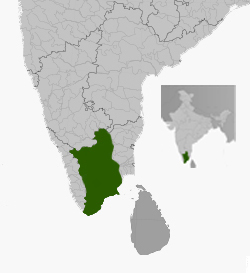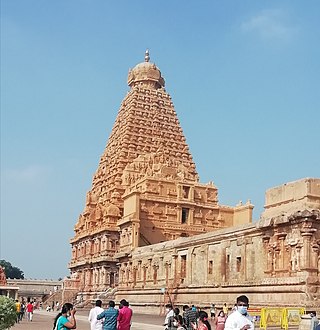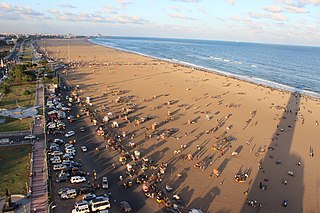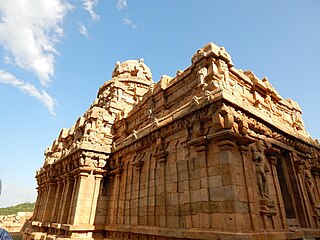
A gopuram or gopura is a monumental entrance tower, usually ornate, at the entrance of a Hindu temple, in the South Indian architecture of the southern Indian states of Tamil Nadu, Andhra Pradesh, Kerala, Karnataka, and Telangana, and Sri Lanka. In other areas of India they are much more modest, while in Southern Indian temples they are very often by far the highest part of the temple.

Sittanavasal Cave is a 2nd-century Tamil Śramaṇa complex of caves in Sittanavasal village in Pudukottai district of Tamil Nadu, India. Its name is a distorted form of Sit-tan-na-va-yil, a Tamil word which means "the abode of great saints".

Koil or Koyil or Kovil, is the Tamil term for a distinct style of Hindu temple with Dravidian architecture. Both the terms koyil and kovil are used interchangeably. In Tamil, kōvil is the word derived, according to the rules of Tamil grammar.
Kalugumalai is a panchayat town in Kovilpatti Taluk of Thoothukudi district in the Indian state of Tamil Nadu. Kalugumalai is 21 km and 22 km from Kovilpatti and Sankarankovil respectively. The place houses the rockcut Kalugasalamoorthy Temple, monolithic Vettuvan Koil and Kalugumalai Jain Beds.

Nellaiappar Temple corridor is a Hindu temple dedicated to the deity Shiva, located in Tirunelveli, a city in the South Indian state of Tamil Nadu. Shiva is worshipped as Nellaiappar represented by the lingam and his consort Parvati is depicted as Kanthimathi Amman. The temple is located on the northern banks of Thamirabarani River in Tirunelveli district. The presiding deity is revered in the 7th century Tamil Saiva canonical work, the Tevaram, written by Tamil saint poets known as the nayanmars and classified as Paadal Petra Sthalam.

Karpaka Vinayaka Temple or Pillaiyarpatti Pillaiyar Temple is a 7th-century CE rock-cut cave shrine, significantly expanded over the later centuries. It is located in Pillayarpatti village in Tiruppathur Taluk, Sivaganga district in Tamil Nadu, India.

Dravidian architecture, or the South Indian temple style, is an architectural idiom in Hindu temple architecture that emerged from South India, reaching its final form by the sixteenth century. It is seen in Hindu temples, and the most distinctive difference from north Indian styles is the use of a shorter and more pyramidal tower over the garbhagriha or sanctuary called a vimana, where the north has taller towers, usually bending inwards as they rise, called shikharas. However, for modern visitors to larger temples the dominating feature is the high gopura or gatehouse at the edge of the compound; large temples have several, dwarfing the vimana; these are a much more recent development. There are numerous other distinct features such as the dwarapalakas – twin guardians at the main entrance and the inner sanctum of the temple and goshtams – deities carved in niches on the outer side walls of the garbhagriha.

The Madurai Nayaks were a Telugu dynasty who ruled most of modern-day Tamil Nadu, India, with Madurai as their capital. The Nayak reign which lasted for over two centuries from around 1529 to 1736 was noted for its achievements in arts, cultural and administrative reforms, revitalization of temples previously ransacked by the Delhi Sultans, and the inauguration of a unique architectural style.

Brihadishvara Temple, called Rajarajesvaram by its builder, and known locally as Thanjai Periya Kovil and Peruvudaiyar Kovil, is a Shaivite Hindu temple built in a Chola architectural style located on the south bank of the Cauvery river in Thanjavur, Tamil Nadu, India. It is one of the largest Hindu temples and an exemplar of Tamil architecture. It is also called Dakshina Meru. Built by Chola emperor Rajaraja I between 1003 and 1010 CE, the temple is a part of the UNESCO World Heritage Site known as the "Great Living Chola Temples", along with the Chola-era Gangaikonda Cholapuram temple and Airavatesvara temple, which are about 70 kilometres (43 mi) and 40 kilometres (25 mi) to its northeast respectively.

Tamil Nadu has the largest tourism industry in India with a percentage share of 21.31% and 21.86% of domestic and foreign tourist visits in the country. According to the 2020 Ministry of Tourism report, the number of domestic arrivals was at 494.8 million making the state the second most popular tourist destination in the country, and foreign arrivals numbered 6.86 million, the highest in the country, making it the most popular state for tourism in the country.

The antiquity of architecture of Karnataka can be traced to its southern Neolithic and early Iron Age, Having witnessed the architectural ideological and utilitarian transformation from shelter- ritual- religion. Here the nomenclature 'Architecture' is as old as c.2000 B.C.E. The upper or late Neolithic people in order to make their shelters, they constructed huts made of wattle and doab, that were buttressed by stone boulders, presumably having conical roof resting on the bamboo or wooden posts into red murram or paved granite chips as revealed in archaeological excavations in sites like Brhamagiri, Sanganakallu, Tekkalakota, Piklihal. Megaliths are the dominant archaeological evidence of the early Iron Age. There are more than 2000 early Iron Age burial sites on record, who laid the foundation for a high non-perishable architecture in the form of various distinct architectural styles of stone built burials, which are ritualistic in its character. The active religious architecture is evident 345 with that of the Kadamba Dynasty. Karnataka is a state in the southern part of India originally known as the State of Mysore. Over the centuries, architectural monuments within the region displayed a diversity of influences, often relaying much about the artistic trends of the rulers of twelve different dynasties. Its architecture ranges dramatically from majestic monolith, such as the Gomateshwara, to Hindu and Jain places of worship, ruins of ancient cities, mausoleums and palaces of different architectural hue. Mysore Kingdom (Wodeyar) rule has also given an architectural master structure in the St. Philomena's Church at Mysore which was completed in 1956, in addition to many Dravidian style architectural temples. Two of the monuments are listed under the UNESCO World Heritage List of 22 cultural monuments in India. Styles of Indo-Saracenic, Renaissance, Corinthian, Hindu, Indo-Greek and Indo-British style palaces were built in Mysore, the city of palaces. Sikh architecture at Bidar (1512) and also in Bangalore in 1956 can also be cited as having an impact on the architectural composition of the state.

The Kampaheswarar Temple or kampa-hara-ishvarar is a Hindu temple dedicated to the god Shiva. It is situated in Thirubuvanam, a village in Thanjavur district in the South Indian State of Tamil Nadu, on the Mayiladuthurai-Kumbakonam road. Shiva is worshiped as "Kampahareswarar" as he removed the quaking of a king who was being haunted by a Brahmarakshasa. It was built by Kulothunga Chola III and is considered the last of the four masterpieces built during the Medieval Chola era. NOW THIRUBUVANAM has a major dominance of Saurashtra people who governed by the head called MR.RAJENDIRAN leader of Saurashtra people

Jainism has an extensive history in the Indian state of Tamil Nadu, although practiced by a minority of Tamils in contemporary times. According to the 2011 India Census, Jains represent 0.12% of the total population of Tamil Nadu, and are of the Digambara sect. Tamil Jains are primarily concentrated in northern Tamil Nadu, in the districts of Madurai, Viluppuram, Kanchipuram, Vellore, Tiruvannamalai, Cuddalore and Thanjavur.

Tamil Nadu is known for its ancient temple architecture known as the Dravidian architecture. Nearly 33,000 ancient temples, many at least 800 to 2000 years old, are found scattered all over Tamil Nadu. As per Tamil Nadu Hindu Endowments Board, there are 38,615 temples. Most of the largest Hindu Temples reside here. Studded with complex architecture, variety of sculptures, and rich inscriptions, the temples remain the very essence of the culture and heritage of Tamil land, with historical records dating back to at least 3,000 years.

Vettuvan Koil in Kalugumalai, a panchayat town in Thoothukudi district in the South Indian state of Tamil Nadu, is a temple dedicated to the Hindu god Shiva. Constructed in the Pandyan Architecture and rock cut architecture, the unfinished temple was built during the 8th century CE by the early Pandyas. The other portions of Kalugumalai hillock houses the 8th century Kalugumalai Jain Beds and Kalugasalamoorthy Temple, a Murugan temple.

Kalugumalai Jain beds in Kalugumalai, a panchayat town in Thoothukudi district in the South Indian state of Tamil Nadu, are dedicated to the Jain religious figures. Constructed in rock cut architecture, the unfinished temple is believed to have been built during the reign of Pandyan king Parantaka Nedunjadaiya. The rock-cut architecture at Kalugumalai is an exemplary specimen of Pandyan art. The other portions of Kalugumalai houses the 8th century unfinished Shiva temple, Vettuvan Koil and Kalugasalamoorthy Temple, a Murugan temple at the foothills.

Vijayalaya Choleeswaram in Narthamalai, a panchayat town in Pudukottai district in the South Indian state of Tamil Nadu, India, is a temple dedicated to the Hindu god Shiva. Constructed in the Dravida style and rock cut architecture, the temple is believed to have been built during the 9th century by Mutharaiyar dynasty kings, the cardinals of Pallavas, with later expansion from the Cholas. The rock-cut architecture is an early example of Cholan Art, continuing the tradition of the Pallavas. The other portions of Narthamalai houses the 8th century Jaina Abode, the Aluruttimalai Jain Caves. There are also two rock-cut caves, one of which houses twelve life size sculptures of Vishnu. The temple is considered one of the oldest stone temples in South India.

Kunnandarkoil Cave Temple in Kunnandarkoil, a village in Pudukottai district in the South Indian state of Tamil Nadu, is dedicated to the Hindu god Shiva. Constructed in Rock-cut architecture, the temple is believed to have been built during the 8th century by Muttaraiyar kings, the cardinals of Pallavas, with later expansion from the Vijayanagar Empire. The rock-cut architecture in the temple is a specimen of the late Pallava Art and an early example of Chola Art. The temple has various inscriptions from Cholas, Chalukyas, Pandyas and Vijayanagar Empire. The temple is considered one of the oldest stone temples in South India. The temple is maintained and administered by Department of Archaeological Survey of India as a protected monument.

Kunnakudi Shanmughanathar temple in Kundrakudi, a village in the outskirts of Karaikudi in Sivaganga district in the South Indian state of Tamil Nadu, is dedicated to the Hindu god Murugan. Constructed in the Hindu style of architecture, the temple is located in the Tirupattur - Karaikudi Road, around 14 km (14,000 m) from Karaikudi. There are three caves located on the western side of the lower rock, that has rock-cut shrines from the Pandyan Empire from the 8th century. The caves have the earliest sculptural representation of Dvarapalas, the guardian deities, for any South Indian temple.





















